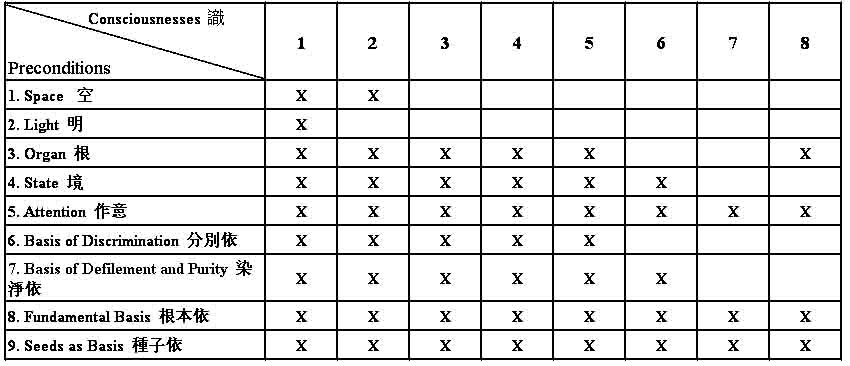|
識生起所需之緣
「和三離二觀塵世,」
眼和耳可以隔距觀聽,但鼻舌身必須要接觸纔能感知。
「愚者難分識與根。」
這裡愚者是指阿羅漢,以及小乘教中層次比較低的眾生,他們不知八識的三分。此三分:自證分、見分、與相分。感
官可照知境界,而意識卻能對之「分別」(見憨山禪師『性相通說』)。
「變相觀空唯後得,」
五識所感知的相分為「五塵」--色、聲、香、味、觸,皆立基於第八識的相分。也皆以第八識的發展和延伸,產生
於識的分別造做。五識立基於五個淨色根,而非浮塵根。如上所說,浮塵根屬於相分的近端部份;而淨色根屬於見分。通過這裡所討論的觀(空),淨色根功用一
變,對相分的執著就被打破了。
「果中猶自不詮真。」
「果」,指達到修行之嚮往目標。如已證之心中還有能、所之分別意識,不管多細微,那都還只是停留在見分上,未
證佛心。
「圓明初發成無漏,」
「圓明」指大圓鏡智。雖然為了再來這個世界,第八地菩薩有意保留下了極微細的習氣煩惱,而其依托就是第八識。
不管怎麼說,此時的第八識已不再是染污的;不再是生死根本了。從這個角度來說,八地為證得大圓境智的初始階段,而佛地乃為其成就階段。「初發」是指在八地
第八識轉成大圓鏡智的這一過程。那個時俱生我執全銷,「得成無漏境界」。
「三類分身息苦輪;」
當第八識轉成大圓鏡智時,前五識亦同時轉成「成所做智」。根塵的關係,已達到清淨無礙的地步。換句話說,佛為
度眾生至彼岸,在運用眼耳鼻舌身時已經完全沒有一點執著和扭曲了。
化身是在使用神通時,從法身而化現之身。法身的「三性身」將在下文的第八識一節中討論。諸佛以權巧示現眾生三
種化身:
(一)為教化十地菩薩而現大化身(等於報身)。(二)小化身--釋迦牟尼佛的丈六之身。(三)隨類化身。這些
化身的覺知功能都是通過「成所做智」而實現的。
待續
|
|
Necessary Preconditions
for the Production of Consciousness

Three perceive the world
of defilement by contact and two perceive it at a distance.
Eyes and ears perceive at a distance, while nose, tongue, and body
perceive through contact.
The foolish have
difficulty distinguishing consciousness from organ.
"The foolish" refers to the Arhats and lesser beings of the Hinayana
teachings, who are unaware of the Three Divisions of the Eighth
Consciousness: the self-verifying division, the perceiver division, and
the perceived division. "Perceptual organs have the capability of
illuminating states, while consciousnesses have the capability of
making distinctions." (Chan Master Hanshan, Xingxiang Tongshuo.)
The transformation of the
perceived division in the contemplation of emptiness is merely Later
Attained Wisdom.
The objects of the five consciousnesses are the five "defilers"—sights,
sounds, smells, tastes, and tangible objects. They have their basis in
the perceived division of the eighth consciousness. That is, they are a
development of the eighth consciousness which takes place because of
further distinction-making. The five consciousnesses have their basis
in the five perceptual organs, that is, the organs of pure form and not
the physical organs. As explained above, the physical organ belongs to
the proximate portion of the perceived division, while the organ of
pure form belongs to the perceiver division. In the contemplation
discussed here, attachment to the perceived division is broken by a
change in the functioning of the organ of pure form.
At the fruition, if there
is still self, there is not total truth.
"At the fruition", refers to reaching the goal of one's practice. If
the enlightened awareness attained still contains the distinction,
however fine, of subject and object, then it is still based on the
perceiver division and not on the Buddha-mind.
At the initial emergence
of perfect clarity, the state of no outflows is realized.
"Perfect clarity" refers to the Great Mirror Wisdom. Although on the
Eighth Ground the eighth consciousness continues to act as the
supporting basis for the extremely subtle spontaneous affliction that
the Bodhisattva purposely preserves as the vehicle of his continued
rebirth in the world, in every other sense the eighth consciousness is
undefiled and no longer the cause of rebirth. From the latter point of
view, the Eighth Ground marks the beginning of the laying of the
groundwork for the Great Mirror Wisdom, which is fully realized at
Buddhahood. "Initial emergence" means that on the Eighth Ground the
process of the transformation of the eighth consciousness into the
Great Perfect Mirror Wisdom begins. At that time "the state of no
outflows" is realized" as the innate attachment to self is eliminated.
Using Three Kinds of
Transformation Bodies, one brings the wheel of suffering to rest.
As the eighth consciousness is transformed into the Great Perfect
Mirror Wisdom, the first five consciousnesses are simultaneously
transformed into the Wisdom of Successful Performance. This wisdom is
characterized by pure and unimpeded functioning in its relation to the
organs and their objects. In other words in their teaching and taking
living beings across to the other shore, the Buddhas' use of their
seeing, hearing, smelling, tasting, and touching is completely devoid
of attachment or distortion.
The transformation-bodies are
bodies which are created using spiritual powers and which are
transformations or emanations from the Dharma-body of the Buddha.
(Three Aspects of the Dharma Body are explained below in the section on
the eighth consciousness.) The Buddhas expediently display for living
beings Three Kinds of Transformation Bodies:
1) a great transformation body to
teach the great Bodhisattvas on the tenth ground (equivalent to the
Reward Body), 2) a small transformation body--the sixteen "foot"
physical body of the Buddha Shakyamuni, and 3) bodies which take on
appearance in accordance with the species of living being taught. The
perceptual functioning of these bodies is accomplished through the use
of the Wisdom of Successful Performance.
To be continued
|